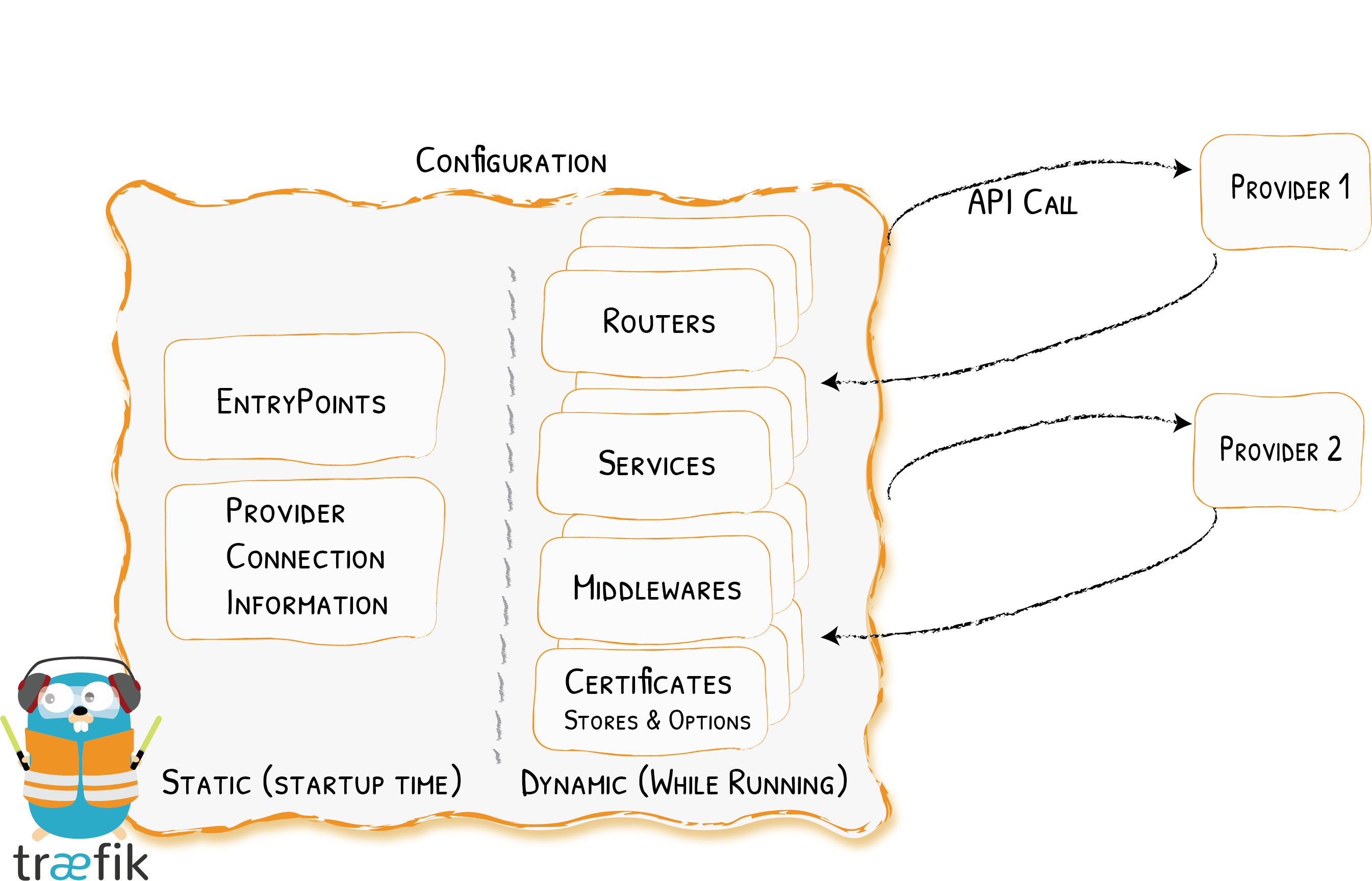Traefik Memo
本篇是學習 traefik 的學習筆記,主要是介紹一些基礎概念, 名詞說明, 使用方式
介紹
Traefik 是一款開源的邊緣路由器,主要功用是發布服務並進行一系列的組織管理。替系統接收請求並找出哪些組件負責處理它們
基本概念
Traefik 是一個邊緣路由器,做為系統平台的入口,它攔截並路由每個傳入的請求,並決定哪些服務處理哪些請求的所有邏輯和規則 
自動化服務偵測 Auto Service Discovery
透過適當的服務集成,在部署服務時 traefik 將能夠自動偵測該部署服務,並提供系列的路由導向配置,無需像傳統邊緣路由器那樣手動配置每個服務,而當服務被移除時,也將自動移除相關的路由配置
Traefik 能夠使用您的 Cluster API 來發現服務並讀取附加信息。 在 Traefik 中,這些連接器被稱為
Provider,因為它們為 Traefik 提供配置。點此查看所有支援的 Provider 清單
配置介紹
請先看下面這張配置說明圖 
Traefik 配置主要分為兩部分
- 啟動配置(Static Configuration): 包含 Provider, Entrypoints 配置
- 動態路由配置(Dynamic Configuration): 包含所有請求處理相關配置,主要為 Routers, Services, Middlewares, Certificates 等部分
啟動配置 - Static Configuration
包含三種互斥(只能同時使用一種)的配置方式
- 單一配置檔案
- 指令列參數配置
- 環境變數配置
1. 單一配置檔案
traefik 啟動時會去下列路徑上尋找檔案 traefik.yml(或是 traefik.yaml, traefik.toml)
/etc/traefik/$XDG_CONFIG_HOME/$HOME/.config/.(Working directory)- 透過
--configFile覆蓋
$ traefik --configFile=foo/bar/myconfigfile.yml
這邊以 Provider Docker 舉例配置如下,詳細配置方法可見這邊
providers:
docker: {} # 預設
# or
docker:
endpoint: "unix:///var/run/docker.sock"
可對應配置一個範例動態路由如下
version: "3"
services:
traefik:
image: traefik:v2.9 # The official v2 Traefik docker image
ports:
# The HTTP port
- "80:80"
# The Web UI (enabled by --api.insecure=true)
- "8080:8080"
volumes:
# So that Traefik can listen to the Docker events
- /var/run/docker.sock:/var/run/docker.sock
whoami:
# A container that exposes an API to show its IP address
image: traefik/whoami
labels:
- "traefik.http.routers.whoami.rule=Host(`whoami.docker.localhost`)"
2. 指令列參數配置
可參考這邊支援的參數列表,這種方式在配置 docker-compose yaml file 時非常方便
version: "3"
services:
traefik:
image: traefik:v2.9
command:
- --accesslog
- --providers.docker
# ...
3. 環境變數配置
可參考這邊支援的環境變數列表
動態路由配置(Routing & Load Balancing) - Dynamic Configuration
大致上處理請求的過程如下圖 
當 Traefik 被啟動時,從我們定義的 entrypoints 進入,接著路由解析並查找是否有該請求對應的路由配置規則,如果有查找到,則將套用對應路由配置中的一系列 middlewares 執行,並最終轉發請求到指定的 Service 服務
到此我們可以簡單釐清下個部分的職責,參考連結:
- Provider: 發現基礎設施上的服務(IP, health)
- Entrypoints: 監聽傳入流量(ports)
- Routers: 分析請求(host, path, headers, SSL)
- Services: 將請求轉發給您的服務(load balancing)
- Middlewares: 可能會更新請求或根據請求做出決定(authentication, rate limiting, headers)
File Provider 動態路由配置範例
此範例中我們透過 File Provider 配置將 http://example.com/whoami/ 轉發到 http://private/whoami-service/
首先進行啟動配置
entryPoints:
web:
# 監聽從 8081 進來的請求
address: :8081
providers:
# 允許透過 file provider 來進行動態路由配置
file:
directory: /path/to/dynamic/conf
接著在 /path/to/dynamic/conf 中,建立一個名為 http.yml 的配置(名子可隨意)
http:
routers:
to-whoami:
rule: "Host(`example.com`) && PathPrefix(`/whoami/`)"
# 如果規則對應成功, 轉發到 whoami service(定義在下方)
service: whoami
services:
# 定義服務在系統上的位置
whoami:
loadBalancer:
servers:
- url: http://private/whoami-service
Entrypoints 支援的所有參數
內容可能會更新,可參考這邊
需注意,預設情況下,沒有提供任何 entrypoints 給 traefik 時,會套用名為
http的 entrypoint 在 80 port,但如果有明確提供任何一個 entrypoint 給 traefik 後,此預設http的 entrypoint 將不會被套用,如果仍然需要使用預設的80port entrypoint 則需要手動將其加入
## Static configuration
entryPoints:
http: # default
address: ":80"
https:
address: ":443"
name:
address: ":8888" # same as ":8888/tcp"
http2:
maxConcurrentStreams: 42
http3:
advertisedPort: 8888
transport:
lifeCycle:
requestAcceptGraceTimeout: 42
graceTimeOut: 42
respondingTimeouts:
readTimeout: 42
writeTimeout: 42
idleTimeout: 42
proxyProtocol:
insecure: true
trustedIPs:
- "127.0.0.1"
- "192.168.0.1"
forwardedHeaders:
insecure: true
trustedIPs:
- "127.0.0.1"
- "192.168.0.1"
HTTPS & TLS
包含兩部分設定 routers, TLS connection,當路由器必須處理 HTTPS 流量時,應使用路由器定義的 tls 字段指定,詳情可見這邊
- 限制進入請求只能為
https
## Dynamic configuration
http:
routers:
my-https-router:
rule: "Host(`foo-domain`) && Path(`/foo-path/`)"
service: service-id
# will terminate the TLS request
tls: {}
- 若需要同時支援 http, https 則需要寫兩個配置,其中一個加上 tls
http:
routers:
my-https-router:
rule: "Host(`foo-domain`) && Path(`/foo-path/`)"
service: service-id
# will terminate the TLS request
tls: {}
my-http-router:
rule: "Host(`foo-domain`) && Path(`/foo-path/`)"
service: service-id
